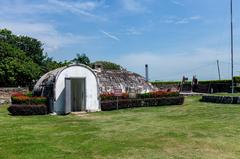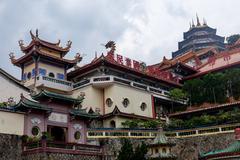Complete Guide to Snake Temple: Visiting Hours, Tickets, and Attractions in Penang, Malaysia
Date: 14/06/2025
Introduction
The Snake Temple in Penang, Malaysia—officially known as Hock Hin Keong or the Temple of Azure Clouds—is a one-of-a-kind spiritual landmark, blending Chinese religious traditions, local folklore, and natural wonder. Located in Bayan Lepas, this temple is globally renowned for the peaceful presence of live snakes, mainly Wagler’s pit vipers, which inhabit its halls and courtyards. The temple honors Chor Soo Kong (Master Qingshui), a Buddhist monk from the Song Dynasty, revered for his compassion and healing abilities. Dating back to the early 19th century, the Snake Temple stands as a testament to Penang’s multicultural heritage and enduring Hokkien traditions (British Malaya Blog; Tabi Together; CJ.my).
This comprehensive guide explores the temple’s historical origins, cultural symbolism, visiting information, and practical travel tips, equipping you for a rewarding and safe experience at one of Penang’s most fascinating sites.
Table of Contents
- Introduction & History
- Historical Background and Origins
- Religious Symbolism of Snakes
- The Flame-Watching Ceremony (Chneah Hoay)
- Community Festivals and Cultural Integration
- Syncretism and Local Beliefs
- The Temple’s Place in Penang’s Heritage
- Resident Snakes: Species, Safety, and Conservation
- Visitor Information
- Special Events and Guided Tours
- Preservation and Heritage Efforts
- Tourism, Feedback, and Practical Tips
- Frequently Asked Questions (FAQ)
- Summary Table of Key Milestones
- Visuals and Media
- Related Articles and Further Reading
- Summary and Recommendations
Historical Background and Origins
Land Grant and Early Structures
The Snake Temple’s site was granted by British authorities in July 1803, reflecting the colonial government’s recognition of Penang’s diverse communities (British Malaya Blog). The original structure likely served as a simple place of worship for the local Chinese community amid dense jungle.
Construction and Dedication
Completed around 1850, the current temple was built by Penang’s Hokkien community to honor Chor Soo Kong, a compassionate Buddhist monk from Fujian Province, China (Tabi Together; Wikipedia). Chor Soo Kong is venerated for his healing miracles and benevolence, and the temple became a powerful symbol of ancestral ties and faith.
Legends of the Snake Inhabitants
According to local lore, Chor Soo Kong sheltered snakes, and after the temple’s completion, snakes began to appear naturally and peacefully on the grounds (Sunway Hotels). The presence of Wagler’s pit vipers became a defining feature, with many believing the snakes are reincarnated disciples of the monk (Differentville; Wikipedia).
Rituals and Symbolism
Incense smoke is believed to calm the snakes, supporting their docile nature. Rituals and offerings blend Buddhism, Taoism, and local animist beliefs, emphasizing healing, protection, and transformation.
Colonial and Modern Evolution
The temple survived urban development, with the local Hokkien Kongsi clan association ensuring its preservation. A breeding facility established in 2005 helps sustain the snake population, even as urbanization reduces their numbers (Wikipedia).
Architectural Highlights
The temple showcases classic Southern Chinese temple architecture: upturned eaves, red and gold motifs, intricate wood carvings, the “Dragon Eye Wells,” and a massive bronze bell imported from China in 1886 (Atlas Obscura). The main hall prohibits incense burning to protect the snakes.
Cultural Significance
The Snake Temple is a major pilgrimage site, especially during Chor Soo Kong’s birthday (sixth day of the first lunar month), drawing visitors from Malaysia and abroad. It has also appeared in global media and literature.
Religious Symbolism of Snakes
Snakes at the temple symbolize transformation, protection, and divine guardianship. In Chinese folklore, snakes are revered as powerful spiritual creatures. The resident Wagler’s pit vipers are seen as sacred, and their calm behavior is attributed to the temple’s tranquil atmosphere and the effects of incense (Differentville).
The Flame-Watching Ceremony (Chneah Hoay)
A spiritual highlight, the annual flame-watching ceremony is held on Chor Soo Kong’s birthday. At 11:30 pm, devotees interpret the incense flames as omens for Penang’s future prosperity or hardship (CJ.my).
Community Festivals and Cultural Integration
During festivals, the temple grounds host cultural performances, traditional food stalls, and the unique snake dance—a local adaptation of the lion or dragon dance. These events foster community bonds and celebrate Penang’s multicultural heritage (CJ.my).
Syncretism and Local Beliefs
The Snake Temple is a living example of religious syncretism, blending Chinese Buddhism, Taoism, and indigenous beliefs. Rituals such as offerings and incense burning reflect this unique harmony (CJ.my).
The Temple’s Place in Penang’s Heritage
The Snake Temple stands as a cultural and spiritual icon, supporting traditional arts, fostering community, and attracting diverse visitors. It exemplifies Penang’s multicultural and tolerant identity (CJ.my).
Resident Snakes: Species, Safety, and Conservation
Snake Species and Behavior
- Wagler’s Pit Viper: The temple’s hallmark species, known for vibrant green coloration and triangular heads (Lexis Suites Penang).
- Other Species: Green tree snakes, pythons, and, in the exhibition area, cobras.
- Safety: Most snakes are devenomed, but their fangs remain. No bite incidents have been reported. Visitors must not touch or disturb snakes and should supervise children closely.
Conservation
Urban development has reduced the snake population, but a breeding center helps maintain the tradition (Wikipedia). The adjacent Snake Farm features over 50 snake species and supports public education and conservation.
Visitor Information
Visiting Hours
- Temple: Open daily, typically from 6:00 AM to 7:00 PM (Travel Penang Malaysia).
- Snake Farm: 9:30 AM to 6:00 PM (Malaysia Traveller).
Ticket Prices
- Temple: Free entry; donations welcomed.
- Snake Farm: RM5 for adults, RM3 for children. Photography with snakes: RM40.
Accessibility
The temple is wheelchair accessible, with ramps at main entrances. Most areas are accessible, though some have steps or uneven ground.
Getting There
- By Taxi/Ride-Hailing: 15–30 minutes from George Town; fare RM30–45 (TripXL).
- By Bus: RapidPenang routes 401, 401E, 102, 305, and 306 serve the temple (Travel Penang Malaysia).
- By Car: On-site parking available (Malaysia Traveller).
Guided Tours & Photography
- Guided tours are available on-site or by arrangement, especially during festivals.
- Photography is allowed, but avoid flash and respect worshippers and rituals.
Facilities and Amenities
- Restrooms, souvenir shops, and food stalls are available, especially during festivals (The Star).
- Dining options nearby include local and international cuisine; several hotels and guesthouses are within easy reach.
Food and Nearby Attractions
- Sample Penang’s famous street food nearby or dine at local restaurants such as Muse Dining Bar and Masala Hut.
- Combine your visit with Kek Lok Si Temple, Penang National Park, or the Penang Bird Park.
Special Events and Guided Tours
Major festivals, including Chinese New Year and Chor Soo Kong’s birthday, feature lively cultural performances, flame-watching ceremonies, and community celebrations (The Star). Guided tours and educational programs are frequently available during these periods.
Preservation and Heritage Efforts
Temple management and local organizations are dedicated to safeguarding rituals, architecture, and the unique role of snakes in Penang’s heritage (CJ.my).
Tourism, Feedback, and Practical Tips
- Dress Modestly: Cover shoulders and knees; remove shoes before entering prayer halls.
- Safety: Do not touch snakes; supervise children; be aware of incense smoke if sensitive.
- Best Time to Visit: Early mornings or during festivals for a vibrant experience (Agoda).
- Accessibility: Most areas are accessible; some steps may be challenging for those with limited mobility.
- Combine Attractions: Make the most of your visit by exploring other Penang historical sites.
Frequently Asked Questions (FAQ)
Q: What are the Snake Temple’s opening hours?
A: The temple is open daily from 6:00 AM to 7:00 PM. The Snake Farm opens from 9:30 AM to 6:00 PM.
Q: Is there an entrance fee?
A: Entry to the temple is free; the Snake Farm charges RM5 for adults, RM3 for children.
Q: Are the snakes dangerous?
A: Most snakes are devenomed and generally docile, but visitors should not touch them.
Q: Is the temple accessible for those with limited mobility?
A: Yes, with ramps at main entrances, though some areas have steps or uneven ground.
Q: Can I take photos inside the temple?
A: Yes, but avoid using flash and respect rituals and worshippers.
Summary Table: Key Historical Milestones
| Year | Event |
|---|---|
| 1803 | Land granted by British authorities for temple construction (British Malaya Blog) |
| 1850 | Completion of the present Snake Temple, dedicated to Chor Soo Kong (Tabi Together) |
| Late 1800s | Snakes begin inhabiting the temple, becoming integral to its identity |
| 2005 | Establishment of a snake breeding facility to sustain the tradition (Wikipedia) |
Visuals and Media
Interactive Map: Locate the Penang Snake Temple
Related Articles
- Top Historical Sites to Visit in Penang
- Cultural Festivals in Penang You Can’t Miss
- Wildlife Attractions in Penang
Summary and Recommendations
The Penang Snake Temple is a unique fusion of spirituality, history, and nature. Visitors are welcomed to explore its rich heritage, witness the legendary resident snakes, and participate in vibrant cultural festivals—all with no admission fee. Respectful behavior, careful observation of safety guidelines, and a sense of curiosity will ensure a memorable and meaningful visit. For the best experience, plan to visit during early mornings or major festivals, and consider combining your trip with other nearby Penang attractions. For up-to-date information, guided tours, and cultural insights, download the Audiala app and follow official channels (British Malaya Blog; CJ.my; Atlas Obscura; Travel Penang Malaysia; TripXL; Differentville; The Star).








